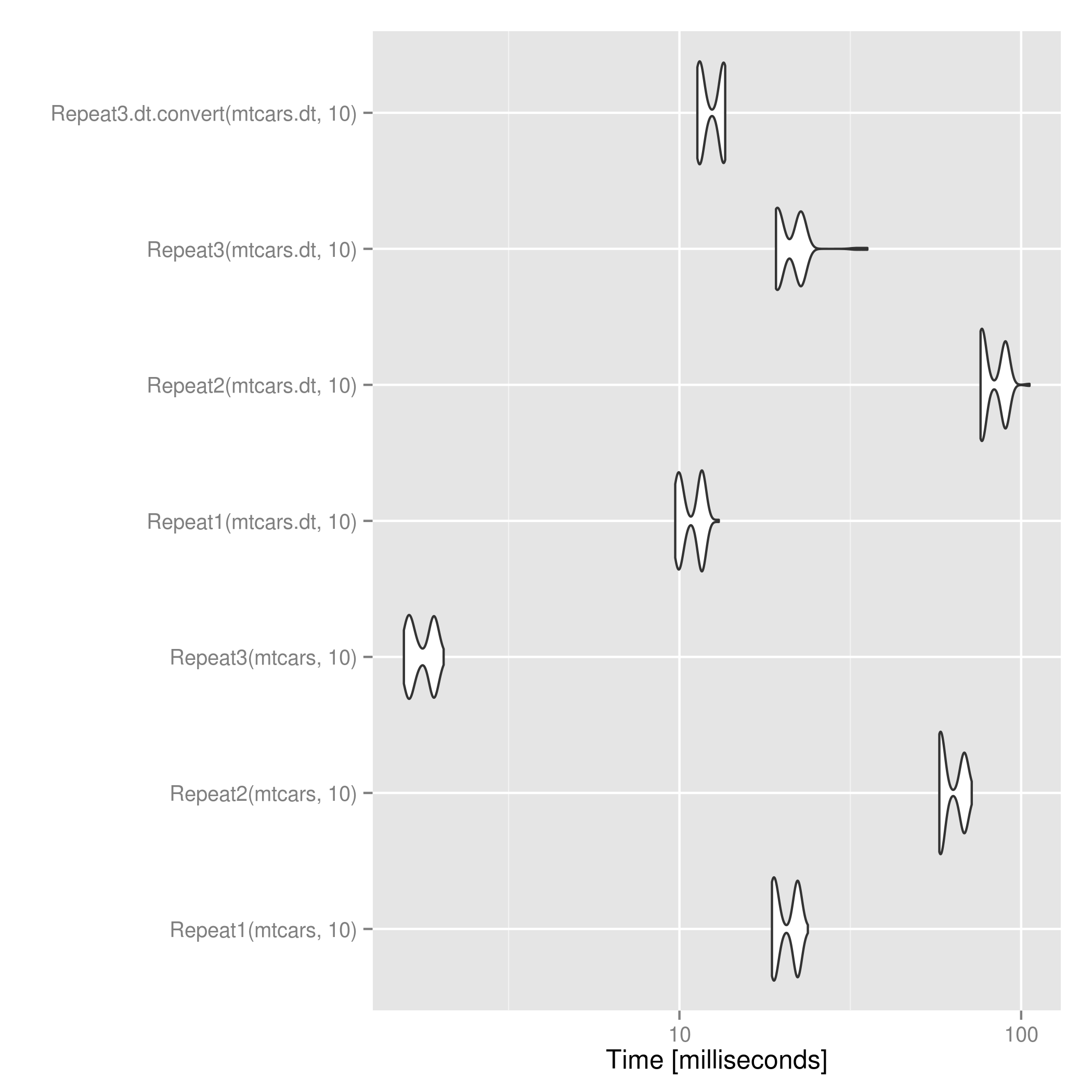重复data.frame N次的行
重复data.frame N次的行
提问于 2012-01-06 04:53:07
我有以下数据框架:
data.frame(a = c(1,2,3),b = c(1,2,3))
a b
1 1 1
2 2 2
3 3 3我想重复这几行。例如,在这里,行被重复3次:
a b
1 1 1
2 2 2
3 3 3
4 1 1
5 2 2
6 3 3
7 1 1
8 2 2
9 3 3在R中有一个简单的函数可以这样做吗?谢谢!
回答 8
Stack Overflow用户
回答已采纳
发布于 2012-01-06 05:23:35
编辑:更新到一个更好的现代R答案。
您可以使用replicate(),然后将结果重新组合在一起。行名将自动更改为从1:nrow运行。
d <- data.frame(a = c(1,2,3),b = c(1,2,3))
n <- 3
do.call("rbind", replicate(n, d, simplify = FALSE))一种更传统的方法是使用索引,但是这里的行名更改并不是很整洁(但更有信息):
d[rep(seq_len(nrow(d)), n), ]下面是对上面的改进,前两个使用purrr函数式编程,惯用purrr:
purrr::map_dfr(seq_len(3), ~d)和不那么惯用的咕噜声(相同的结果,虽然更尴尬):
purrr::map_dfr(seq_len(3), function(x) d)最后,通过索引而不是列表使用dplyr应用
d %>% slice(rep(row_number(), 3))Stack Overflow用户
发布于 2015-02-13 18:55:46
对于data.frame对象,该解决方案比@mdsummer和@wojciech的快几倍。
d[rep(seq_len(nrow(d)), n), ]对于data.table对象,@mdsummer的应用比转换为data.frame后的应用要快一些。对于大的n,这可能会翻转。

。
完整代码:
packages <- c("data.table", "ggplot2", "RUnit", "microbenchmark")
lapply(packages, require, character.only=T)
Repeat1 <- function(d, n) {
return(do.call("rbind", replicate(n, d, simplify = FALSE)))
}
Repeat2 <- function(d, n) {
return(Reduce(rbind, list(d)[rep(1L, times=n)]))
}
Repeat3 <- function(d, n) {
if ("data.table" %in% class(d)) return(d[rep(seq_len(nrow(d)), n)])
return(d[rep(seq_len(nrow(d)), n), ])
}
Repeat3.dt.convert <- function(d, n) {
if ("data.table" %in% class(d)) d <- as.data.frame(d)
return(d[rep(seq_len(nrow(d)), n), ])
}
# Try with data.frames
mtcars1 <- Repeat1(mtcars, 3)
mtcars2 <- Repeat2(mtcars, 3)
mtcars3 <- Repeat3(mtcars, 3)
checkEquals(mtcars1, mtcars2)
# Only difference is row.names having ".k" suffix instead of "k" from 1 & 2
checkEquals(mtcars1, mtcars3)
# Works with data.tables too
mtcars.dt <- data.table(mtcars)
mtcars.dt1 <- Repeat1(mtcars.dt, 3)
mtcars.dt2 <- Repeat2(mtcars.dt, 3)
mtcars.dt3 <- Repeat3(mtcars.dt, 3)
# No row.names mismatch since data.tables don't have row.names
checkEquals(mtcars.dt1, mtcars.dt2)
checkEquals(mtcars.dt1, mtcars.dt3)
# Time test
res <- microbenchmark(Repeat1(mtcars, 10),
Repeat2(mtcars, 10),
Repeat3(mtcars, 10),
Repeat1(mtcars.dt, 10),
Repeat2(mtcars.dt, 10),
Repeat3(mtcars.dt, 10),
Repeat3.dt.convert(mtcars.dt, 10))
print(res)
ggsave("repeat_microbenchmark.png", autoplot(res))Stack Overflow用户
发布于 2017-08-11 15:30:22
包dplyr包含函数bind_rows(),该函数直接组合列表中的所有数据帧,因此不需要将do.call()与rbind()一起使用。
df <- data.frame(a = c(1, 2, 3), b = c(1, 2, 3))
library(dplyr)
bind_rows(replicate(3, df, simplify = FALSE))对于大量重复,bind_rows()也比rbind()快得多
library(microbenchmark)
microbenchmark(rbind = do.call("rbind", replicate(1000, df, simplify = FALSE)),
bind_rows = bind_rows(replicate(1000, df, simplify = FALSE)),
times = 20)
## Unit: milliseconds
## expr min lq mean median uq max neval cld
## rbind 31.796100 33.017077 35.436753 34.32861 36.773017 43.556112 20 b
## bind_rows 1.765956 1.818087 1.881697 1.86207 1.898839 2.321621 20 a 页面原文内容由Stack Overflow提供。腾讯云小微IT领域专用引擎提供翻译支持
原文链接:
https://stackoverflow.com/questions/8753531
复制相关文章
相似问题

